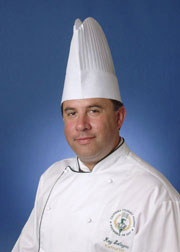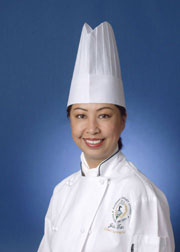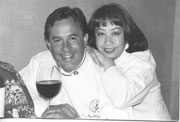How many knights do you know who have raced vintage cars and taught at the California Culinary Academy? Or visual display artists equally versed in the secret Malaysian Nonya and French cuisines? These diverse sets of skills and experiences can be found in Roy Salazar and Julie Tan, each of whom has worked professionally with Martin Yan of Yan Can Cook.
Both Julie and Roy were educated at the California Culinary Academy/Le Cordon Bleu (CCA) in San Francisco years ago, and I had the honor of tasting some of their own cooking in the academy’s main dining room. I have enjoyed many of their concoctions since, but was particularly interested in their ideas on wine and food pairing, as both are certified Master Tasters and have taught classes in wine and food pairing at CCA.
Thoughts On Food and Wine Pairing
Roy Salazar
Salazar
"If something has an extreme element in it, I try to counterbalance it. For example, buttered popcorn with a malolactic chardonnay. Butter has too much fat, so I fix it with the acid of the wine. They both have a butter flavor, so work with similar flavors and use contrasting flavors, as well.”
An example of contrasts in matching is “…buttered popcorn with Coke. Buttered popcorn is salty, Coke is sweet. Buttered popcorn is fatty, Coke has acid. They work.”
To restate, “I agree with Tim [Hanni] on many issues. The universal matching will bring a person to an 80% satisfaction and matching agreement, yet there are some matches per person (individualized), that will satisfy a person 100%.”
Complex wines paired with food can “rock my world”, much like driving an expensive, beautiful Porsche on a winding road. “I enjoy luxury wines for the pure taste and complexity of these…each taste is like making a sharp turn at a high speed. It, needless to say, is very exciting.”
Julie Tan
Tan agrees with Salazar’s pairing philosophies and also in the newer, basic principles of food and wine matching, with a footnote. The basic principles are:
- consider personal preferences
- realize foods of a particular region tend to go well with wines of the same region
- don’t let wine overpower the food
- don’t let the food overpower the wine
- pair wine and food with either similar or contrasting aspects (illustrated above in Salazar’s popcorn example; i.e., buttered popcorn with buttery wine or buttered popcorn with Coke)
These guidelines are an update to the old thinking that red wine goes with red meat, white wine with chicken or fish, and other such rigid prescriptions. Breaking these principles will work 
Tan comments further that she likes to match her food with wines similar in strength, such as a lamb dish with a full-bodied wine—shiraz or cabernet. “The fattiness of duck goes really well with the acids of a pinot noir”, she adds as another example.
Folks also ask Tan about matching Chinese foods with wines, but because of the family-style nature of the meals, pairing is difficult. Typically, one sitting could include beef, fish, vegetables, tofu, seafood, noodles and rice, all with different sauces. But a rule of thumb is to pair such foods with an equally delicate wine.
Matching desserts with wine is a little different. “The wines have to be sweeter or as sweet as the dessert to make it work. Try a sip of merlot or cabernet with a bite of chocolate and you will know that it is not a match made in heaven.”
Both Salazar and Tan discussed the fact that, throughout history, folks adjusted their wine to go with the food, either by tossing in some sugar if the wine was too bitter or by adding water if the wine was too strong.
At present, we adjust the food to work with the wine. People rarely do anything to change a wine, although some whisper that they occasionally throw in a piece of ice to cool a white. But the act is considered a sin by many.
The Car Racing Knight, Sir (and Chef) Roy Salazar
Roy Salazar is a Certified Executive Chef, Culinary Educator, Master Taster and graduate of the California Culinary Academy, as stated above. Roy has taught numerous classes at CCA: French Cuisine, Chocolate, Food and Wine Pairing, Basic Wine, Advanced Wine, Food Anthropology, Nutrition, Stocks, Sauces and Advanced Business. He is qualified to teach just about any class at the academy.
Other culinary activities include developing products for companies such as Coca Cola and Frito Lay, acting as tasting and kitchen equipment judge at America’s Chefs’ Best, presiding over the Chefs Association of the Pacific Coast (San Francisco chapter of the American Culinary Federation), contributing to the book, Chinese Cooking for Dummies by Chef Martin Yan, and acting as a personality representing the Nu Wave Oven in an infomercial.
The excitement doesn’t stop there. Salazar holds several honors within the cooking world and without. He is the 137th recipient of the international Antonin Carême Medal, also bestowed upon Julia Child and Martin Yan. Only 137 medals have ever been awarded since commencement in the 1800s. He also holds the San Francisco and Pacific Coast Chef of the Year award and the American Culinary Federation Presidential Medal.
Like his interests, his education is wide-ranging, including West Point Military Academy (military tactics and pistol shooting), University of San Francisco Business School, Golden Gate University Law School (basic law), Harvard Law School (legal negotiations), Oxford University (international relations and law) and the Culinary Institute of America.
Finally, the knighthood. Salazar was named Sir Roy Joseph Salazar in 2005 by the King of Portugal, and will soon receive the additional title of Commander, or Commander Sir Roy Joseph Salazar. The title of Sir is to be used throughout the world for services rendered to the royal crown, majesty and government.
In 2008, Roy Salazar will again be knighted in England by the Queen for services rendered to the crown!
He also participates in pistol shooting (Olympic team member in the 1980 games), fencing, archery and surfing, and continually takes up new sports. At one point, he raced a 1959 Porsche to victory in a race from the San Francisco Ritz Carlton to Napa Opus One.
Artist and Nonya Expert, Chef Julie Tan
Julie Tan is Executive Chef for Le Culinaire Concierge (a team building company), tasting and kitchen equipment judge at America’s Chefs’ Best and member/recipe developer for the Chef’s Council at the Center for Culinary Development. Like Salazar, she taught several classes at CCA: Principles of Asian Cuisine, French Cuisine, Chocolate, Food and Wine Pairing, Soups and Stocks, Thai, Noodles, Chinese and various consumer education classes. Tan is a certified Executive Chef, certified Culinary Educator and certified Master Taster.
Chef Martin Yan, known to many from the PBS television show, Yan Can Cook, plays a strong and fascinating role in Tan’s career growth. With him, she has had the opportunity to work as TV studio coordinator and even appear on Yan’s PBS series Asian Favorites. Tan has also served as a recipe and cookbook developer for his cookbooks Chinese Cooking for Dummies and Asian Favorites. Most recently, Yan has assigned her the role of Principle Lecturer and Advisor to his Culinary Institute of China!
Tan is Demo Chef for several organizations: General Electric, Laney College, City College and the Yan Can Cook International School.
As if there were even time for further commitments, Tan has involved herself in activities that resulted in two firsts for women: first female Vice President of the Chefs Association of the Pacific Coast, of which her husband is President, and only female member, to date, of the Gastronome Club of San Francisco.
Julie Tan received an Associate of Arts degree in Visual Display from the Institute of Design and Merchandising. Subsequently, she graduated from the Culinary Academy.
In addition to the vast culinary knowledge already listed, Tan knows Nonya Cuisine, a secret cuisine in Malaysia. She learned the art as a child from her mother and grandmother, as close family recipes passed from one generation to the next. Nonya is a marriage of Chinese and Malay cuisines, but is creatively seasoned unlike either Chinese or Malay food. Nonya can be considered one of the first true fusion cuisines (!) grown out of the fusion of the two peoples, united during the Ming Dynasty when the Chinese emperor married his daughter to the Sultan of Malacca, whose port lay on the Malayan Peninsula.
Joint Activities
In their company called A Sip & A Taste, Roy and Julie participate in cooking demos that exhibit their wine and food pairing skills for many national companies, one being General Electric. To help attract customers to the company’s wine vaults (8 x 8-foot, personal walk-in wine storage systems) Roy works on the wine aspect, and Julie handles the foods for matching. They prepare the pairings and serve them to customers in the custom tasting areas of the vaults. Clients then often become interested in purchasing the vaults. See http://www.monogram.com/selectionguide/wine_vault/index.htm.





